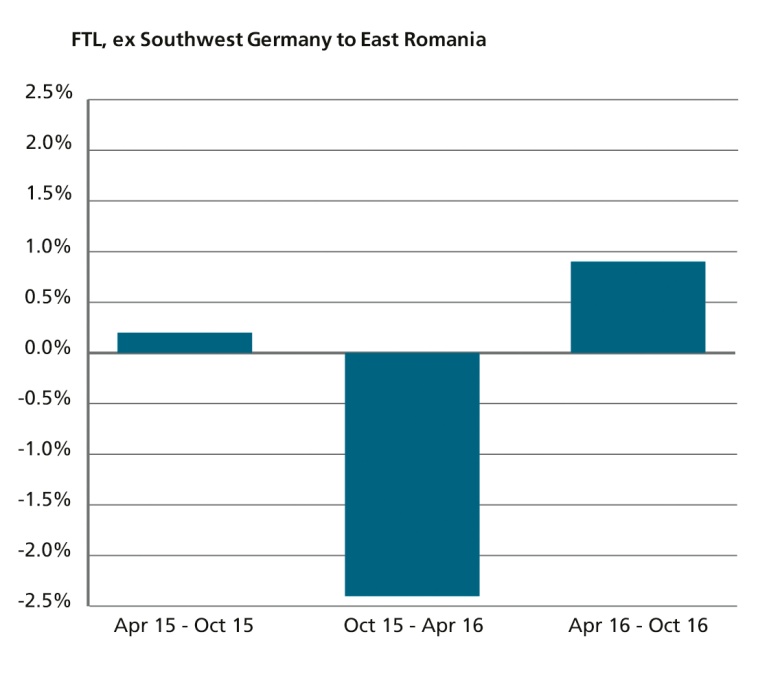Closer Look on Freight Rates





Creating more transparency for the chemical industry’s European transport market is the purpose of the Fraunhofer freight cost barometer, which has been published in the German edition of CHEManager newspaper twice a year since 2016. The barometer clearly illustrates developments in freight costs for the Full Truck Load (FTL), Less-Than-Full Truck Load (LTL) (0.5–7.5 t) and Bulk Tank segments.
More than ten well-known companies from the European chemical industry, which have been comparing anonymized data in their own Freight Benchmarking Group since 2005, provide the basis for the data. The group receives scientific methods and professional group facilitation from the Fraunhofer Center for Applied Research on Supply Chain Services SCS in Nuremberg as well as an antitrust lawyer.
The freight cost barometer devised for CHEManager represents the highest aggregation stage of the benchmarking evaluations. In addition, twice a year the group participants receive the detailed information relevant for them based on relations and regions. As well as price developments over time, the current absolute prices can also be compared. Using three selected excerpts, current benchmarking group results are presented below.
Freight Cost Barometer – Mixed Results for Freight Rate Development in 2016
For the freight cost barometer, the price changes of all relations are aggregated into a clearly structured diagram (fig. 1). For European road freight transport, Fraunhofer SCS’s evaluation of freight rate benchmarking for 2016 reveals a slight price decrease in the Bulk Tank segment, price stagnation for packaged goods in the Full Truck Load (FTL) segment, and an increase in freight rates in the Less-Than-Full Truck Load (LTL) segment.
In the previous half-yearly evaluation up to April 2016, prices had gone down in all transport segments (Bulk Tank: -0.7%; FTL: -1.9%; LTL (7.5 t): -1.7%; LTL (2.0 t): -1.6%, and LTL (0.5 t): -2.5%). This was attributable in part to the sharply falling price of diesel (-11.1%). Analysis of the current evaluation period, however, reveals that the price of diesel has increased for the first time in a few years, going up by over 2%. Consequently, other market developments – such as changes in capacity and demand – are stronger causes for the development of freight rates.
In the Bulk Tank segment, the slight decrease (-0.6%) holds throughout almost all observed country relations, although the strength of the reductions varies. For example, tours from Benelux countries to Italy show a reduction of over -2%, whereas the prices for internal German tours remained largely stable. The situation is different for the FTL segment, where we can see strong regional differences, such as price decreases of up to -2.4% for Germany-Czech Republic relations and price increases of almost 3% such as for France-Benelux, but where overall prices are stagnant (-0.1%). For the Less-Than-Full Truck Load segment, once the freight rates across all observed European countries have been aggregated, there is a price increase in each weight category (LTL (7.5 t): 0.8%. LTL (2.0 t): 1.2% and LTL (0.5 t): 0.5%). Consequently, although there are regions in all three segments where freight rates have fallen, the price increases for certain relations, such as Germany to Switzerland, have been all the more pronounced.
Price Index Development – Normalization of Rates after the Economic Crisis
Figure 2 displays the price index development of freight rates for all Bulk Tank tours that start in Benelux countries. Starting at the price index of 100, the graph shows the development of prices over time, using the rate of October 2009 as the reference value. Their progress is depicted for the last seven years, with two reference points a year. The curve shows that in 2010, following a sharp decline in freight rates precipitated by the global recession starting in 2008 (not illustrated), a turnaround occurred and prices rose again. Over the next three years, a mark-up of over 14% lifted freight rates almost to their pre-crisis level, reaching a high of 111.4 in October 2012. Beginning with April 2013, a phase commenced in which prices either stagnated or dropped by up to -2% per half-year period. The only exception is the period from April 2015 to October 2015, for which the index temporarily increased again from 106.2 to 107.7.
Rate Change – Bucking the Wider Trend
The rate change illustrates the current, specific price changes. While aggregated information – such as that provided in figures 1 and 2 – gives an overview of trends, freight rates are usually negotiated on a more regionalized level. These more specific prices often follow larger developments. But as capacity and demand may differ in each region, it may be necessary to take a closer look at the resulting deviations. Figure 3 provides an excerpt of a more in-depth analysis. It shows the changes in the last three half-year periods for FTL tours going from the southwest of Germany to the east of Romania. It gives a good example of how regionalized freight rates often develop differently and more distinctly than their aggregated trends. From April 2015 to October 2015, the freight rates for these tours first rose slightly (0.2%), followed by a sharp fall (-2.4%). The last bar shows a rise of 0.9% for the period from April 2016 to October 2016, even though European FTL tours in general stagnated (see fig. 1: -0.1% for FTL).
Members welcome at Freight Benchmarking Group
The Freight Benchmarking Group for the European chemical industry was established by Fraunhofer SCS in 2005 and currently comprises more than ten leading chemicals companies. The group provides chemicals manufacturers and feedstock suppliers with anonymized freight rate comparisons, helping to strengthen their negotiating position and improve their procurement strategies. Participating companies receive benchmark findings twice a year in the form of detailed country- and region-specific reports plus summary reports on general market conditions. The data is made available online via a web portal. The entire group convenes once a year to evaluate selected findings. At these meetings, invited experts and Fraunhofer researchers give presentations on current market trends. The benchmarking group is structured as an open working group, and suitable companies are welcome to join.
Company
Fraunhofer SCSNordostpark 93
90411 Nürnberg
Germany
most read

US Tariffs Fatal for European Pharma
Trump's tariff policy is a considerable burden and a break with previous practice.

Lead or Lag: Europe’s AI Materials Race
How AI and Robotics are reshaping the race for materials discovery.

Pharma 4.0—the Key Enabler for Successful Digital Transformation in Pharma
Part 3: Seven Theses for successful Digitalization in Pharma

ISPE Good Practice Guide: Validation 4.0
The Validation 4.0 Guide provides a comprehensive approach to ensuring product quality and patient safety throughout a pharmaceutical product's lifecycle.

Relocation of Chemicals Production Footprint in Full Swing
A new Horváth study based on interviews with CxOs of Europe’s top chemical corporations reveals: The majority of board members expects no or only weak growth for the current year.











